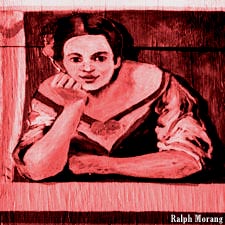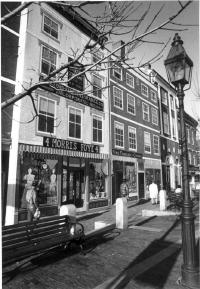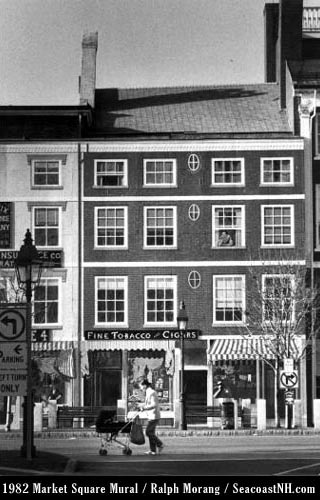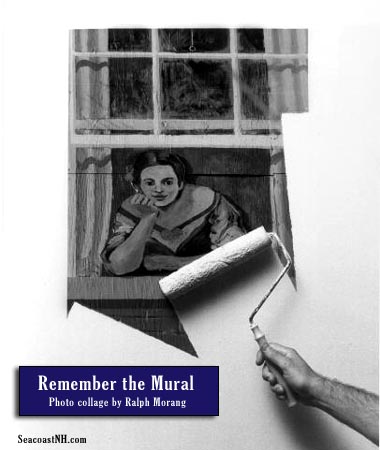| Reflections on a Painted Wall |

MARKET SQUARE MURAL 1982
In 1982, although few people noticed, a tiny rift appeared in the time-space continuum. It happened in Market Square in Portsmouth, NH. The author was there and so was photographer Ralph Morang who captured the quickly fading phenomenon. If you were not there, here is how the anomaly went down. The past, you see, is studying us, not the other way around.
READ about a Dover mural
There really are wormholes in time. I saw one more than 20 years ago In Portsmouth. Ask people who were downtown during the last few pendulum swings of 1983. They'll back me up.
 Portsmouth is often chronologically disorienting. You pick up the classic clopping of hooves on cobblestone. You see a man in a top hat duck down a Victorian alley, or you spin to glimpse a cloud that you'd swear, moments before, was the unfurled curl of a tall ship up river. Residents just nod. When you live in a historic town, hallucination comes with the territory.
Portsmouth is often chronologically disorienting. You pick up the classic clopping of hooves on cobblestone. You see a man in a top hat duck down a Victorian alley, or you spin to glimpse a cloud that you'd swear, moments before, was the unfurled curl of a tall ship up river. Residents just nod. When you live in a historic town, hallucination comes with the territory.
Spending too much time, as I do, paging through brittle books and archived photos puts me squarely in the high risk category for Twilight Zone-like encounters with the past. But I've had disappointingly few, being endowed with more curiosity than imagination and more energy than memory. My brain is just too darn rational; it demands so many triangulation points, takes so few risks, asks endless trivial questions that it can't get off the launch pad to pierce the temporal curtain for more than a few seconds at a time. Maybe it's just afraid. My mother used to warn her little boys not to cross their eyes too many times or they would get stuck that way. Maybe if you think too hard about history, you wind up back there, trapped forever without toothpaste, hot showers or toilet paper. It's a scary thought. My brain may just be protecting me.
So I was particularly surprised to see that wormhole open of its own accord one day in the middle of Market Square back in the fall of 1982. This was no transient phenomenon. There was no need for parapsychologists wearing headphones sweeping the air with ghostbuster equipment. This was a full blown in-your-face breach in the space-time continuum. Everybody saw it.
It all started when the Foye Building fell down on December 23, 1981. Actually it just moaned and shivered and crunched a bit as a brick wall gave way. The details are distracting, but there were lawsuits and recriminations. No one was hurt and the decision to rebuild eventually came around.
To mask the reconstruction site and protect passersby, the builders put up a giant wall made from 50 sheets of four-by-eight foot plywood. It was ugly. Every journalist in town, myself included, described it as a monstrous missing tooth, an unsightly gap in our beloved gentrified downtown. It hunkered there obscenely between the Portsmouth Athenaeum and what is now Starbucks, leering across the street at the Old North Church. We hated it.
Enter the Fantastic Five. We tend to put the wrong names of people on plaques -- wealthy founders, accidental heroes, politicians. But the men and women who speak to our souls get diddly. Five local artists decided to paint the plywood wall. They were nuts, of course. The planned two week project took 12 weeks and the all-volunteer team sacrificed income, sanity and relationships to fill in the gap. The plaque that isn't there should read -- Cary Wendell, Steven Lee, Pat Splaine, Thom Cowgill, Valerie Cooper. Others helped and will go equally unrewarded.

CONTINUE "Reflections on a Painted Wall"
MEMORIES OF THE MARKET SQUARE MURAL (Continued)
What they did was brilliant. The muralists filled in the 1,600 square foot hole with a painting of the same two buildings it covered -- but with a twist. The former Foye and Pierce buildings were depicted as they had been nearly a hundred years earlier. The differences were subtle, old store signs reappeared, doorways aged. The finely crafted detail included 19th century items in a bakery window, even ghostly shop owners and painted reflections of Market Square as it once was. The bricks looked like bricks, the granite lintels and wood trim were hauntingly realistic. The tromp d' ceil ("fool the eye") style was so successful that pigeons attempted to land on the window sills. The town was enchanted by the biggest painting in its history. The mural artists called it a giant business card and it got them some jobs -- the nave of a catholic church, another exterior, a prison cafeteria.
Behind the wall, construction continued. In front, the spindly new trees changed color and dropped their leaves. From across Market Square, people passing on Congress Street seemed to enter a huge Polaroid of old Portsmouth, and seconds later, to re-enter the modern world. This scene, repeated again and again, formed swirling eddies of time. Often fallen leaves mixed with bits of litter would get caught in the spin cycle, and although no one noticed, here and there, a few seconds fell out of step and were lost forever. One man in the painted store shifted position and a painted reflection in a painted window changed color, now and again, with real sunlight on the Square.
These were the warning signals of the temporal storm that erupted with the coming of the woman in the window. She appeared one day leaning out from the third floor. She was decidedly Spanish, young with soft skin and dark hair. She wore a dress wide open at the neck and appeared to have a flower in her hair. Propping her head in one hand, she gazed with fascination into the street below. Everything amazed her, even the empty street at night, night after night, through the winter and into the spring until the wall came down around her.
What the mural artists really built was, of course, a time machine. We've all seen the movies and that's why we were fooled at first. Movie time machines have dials, a comfortable seat or at least an ornate portal to pass through. They make noise, spark or hiss and emit clouds of smoke. There is always music. We've been programmed to think that when the machine is moving, things get blurry. Time passes in a hurricane, Hollywood tells us, but it doesn't. A few leaves may spin and a few seconds may get lost, but on the surface, at least, the phenomenon is a gentle one. That's why the wormhole doesn't show up well in photographs, but it's there.
The woman in the window turned out to be a prostitute. The artists admitted the truth and some of the town fathers and mothers were shocked. But no one could quite figure out how to arrest a painting of a prostitute. There were those who even admitted that Portsmouth's old "red light" district had probably contributed as much to the local economy as the more legitimate enterprises of slavery and privateering. The woman was allowed to remain at her window and the artists were allowed to remain unheralded and unpaid. The wormhole, which seemed to localize around the painted prostitute, was allowed to continue doing what wormholes do.
As I recall, I didn't see the wormhole right away. My rational brain kept telling me that the whole scene was made of plywood, though something deep inside knew better. I kept trying to imagine the rest of Portsmouth at the turn of the century, using the mural as the launch pad for my weak imagination. I filled the streets with carriages, a fountain in the center, the smells of horse and hay and rotted food and burning coal. I blocked out the sounds of cars, plugged in the sounds of distant ships, a train, wheels on an untarred road. I concentrated so hard my eyes crossed, but I was not transported.
Which is about the time, lifting my head in frustration, that I saw the wormhole. Funny how you miss the obvious stuff. The woman in the window had, all this time, been staring right at me, fascinated, I assumed by my oddly styled clothes, not to mention the strange cars. The North Church steeple had been painted brown in her day, not white. The stores were all so changed, so brightly lit.
She was thinking, I can only assume, of how different her life might have been. What if she'd been born in the future, say a hundred years ahead. Strange visions filled her mind and she leaned a bit further out the window. The curtains on each side of her floated a bit in the salt breeze from the harbor and, for just a second, she saw things that amazed her. No one would ever believe her fantastic descriptions of the future, but they stayed with her, filling her dreams throughout her short unhappy life. Then she blinked to clear her brain, the wormhole flashed in her eyes, and was gone.
Copyright © 2005 by J. Dennis Robinson. All rights reserved. First published in 1997.

